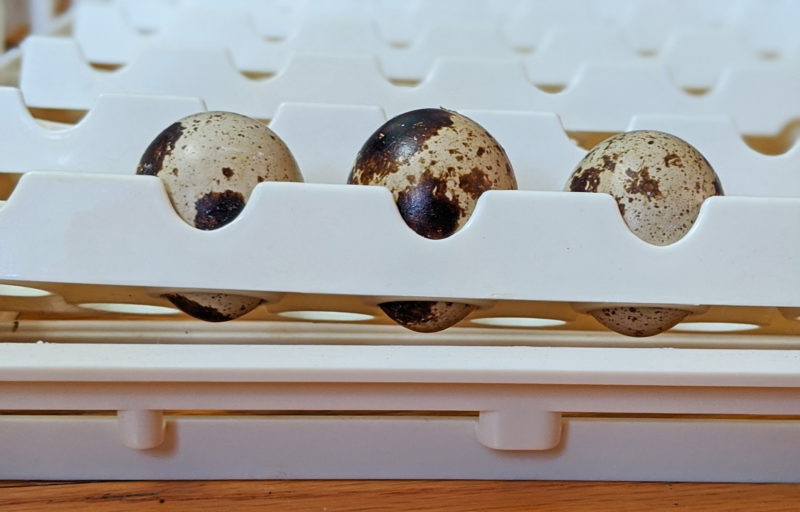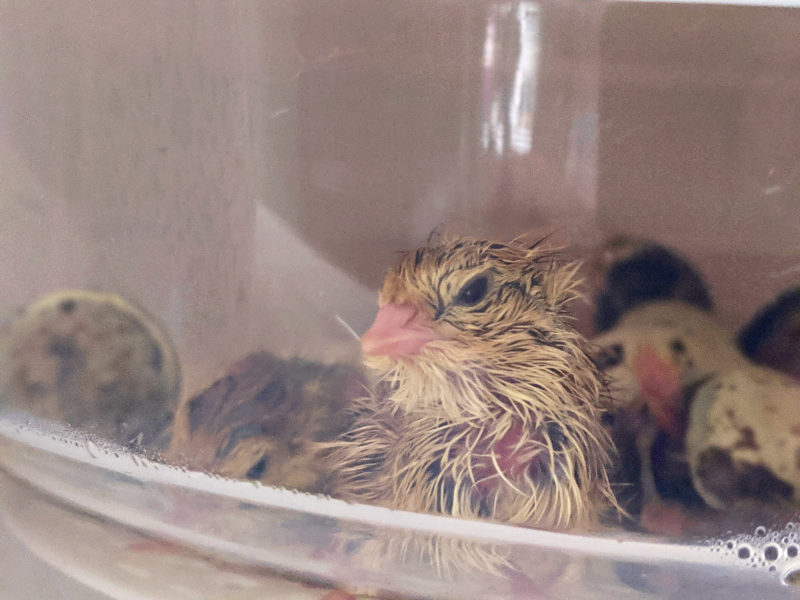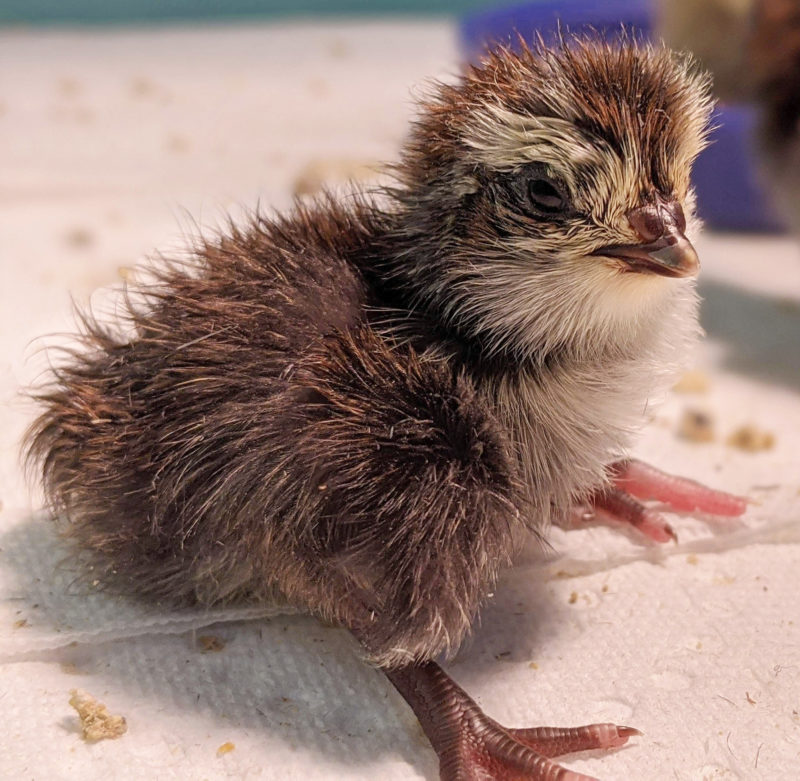Incubating and hatching your own quail is rewarding for you and your family. (All photos by author.)
Hatching Japanese Coturnix quail can be a delightful experience. Despite their diminutive size and tiny cheeps on hatching day, quail chicks are resilient and grow very quickly. Incubation requirements for quail are a little different than those for chickens and other fowl, but are easy to accommodate.
Finding the Right Incubator
Buying the right incubator is the most crucial part of hatching. In my experience, an incubator needs to have a built-in thermometer, hygrometer, automatic turner, and fan (forced air system). While hatching is possible without one or any of these attributes, incubating becomes much more time-intensive and risks a lower hatch rate. Nearly all incubators available to purchase have a built-in thermometer and sometimes a hygrometer (to monitor moisture). Many also have a forced air system, which circulates air in the incubator to keep an even temperature throughout. It’s important to read the reviews for the model in question, as well. Reviews may reveal a tendency for the incubator to run too hot or cold, or perhaps become less accurate over multiple hatches.
Automatic Turner
I consider an automatic turner a necessity, especially for quail eggs. Turning by hand is possible, but it requires frequently opening the incubator and disrupting the temperature and humidity levels. In addition, quail egg shells are extremely thin, and any additional handling risks damage to the egg. Furthermore, many people put an “x” in pencil on the shells when hand-turning, but this is much harder to see with the natural camouflage of quail eggs.
Rails
Some automatic turners use rails, so if this is the type of model you’re considering, ensure that there are quail egg rails available. These usually need to be purchased separately. Some incubators don’t use rails, but rather have the eggs between slats in a box that slides across the floor, turning them as they go.

Eggs point down in the turner rails.
This design adjusts to a variety of egg sizes, so no additional purchase should be necessary. Depending on the number of eggs you want to hatch and anticipated frequency of hatches, you may want to spend a little less for a smaller incubator, or a little more for larger capacity and positive feedback on its long-term durability. Keep in mind that a larger-capacity incubator can still incubate a small number of eggs; it doesn’t have to be full to operate.
Observation Windows
Some incubators have small observation windows on top, while others have a clear plastic lid, or are made entirely of clear plastic. I’ve found that the smaller observation windows are prone to fog over with the high humidity required in the last days of hatching. It may be important to you to be able to watch the chicks hatch, in which case a clear lid or larger observation window would be ideal. This design makes it easy to keep an eye on which eggs have pipped, or if it seems like a chick is struggling during the hatching process.
Where to Find Quail Eggs
If the incubator runs as expected, it’s time to set the eggs! There are many places to buy Coturnix quail eggs online. Many breeders ship only on specific days of the week and may have some lead time built in before shipping, so be aware of this with your hatching timeline. Make sure to order eggs specifically designated for hatching, as quail eggs can also be sold for eating or crafting and are not viable to hatch. There are multiple plumage color varieties to choose from, and Celadon eggs (blue-green eggs) are also available from some sellers. In the product description, note if a hatch rate guarantee or extra eggs will be included. These are not necessarily standard practices, but good perks if offered. There may also be pictures of the packaging they use. Foam squares with cut-outs that the eggs nestle into are ideal, as they increase the safety and integrity of the eggs in transit.

When you order eggs, they’ll come packaged in foam.
Local Sellers
If you can find a local seller, you may be able to pick up the eggs in person. This is the best option, if possible, since the eggs spend the least time in shipping and aren’t exposed to variable temperatures. Farm supply stores occasionally carry or special-order Coturnix eggs, but there’s usually a required minimum of 50 eggs or more (more than my current capacity for quail!). If you have a few friends who’ll go in with you on a larger batch, that can be a helpful option.
Eggs from Your Flock
If you already have quail, you can also hatch eggs from your own stock. Collect the eggs daily, and if you need to collect over the course of a few days to gather enough for your hatch, store them at the mid-50-degree-Fahrenheit range, with the points facing down. A fridge is too dry and cold for this. Eggs should be less than a week old when set in the incubator for better hatch yields. Avoid washing the eggs, as this removes the protective mother on the shells. If there’s visible dirt on the egg, gently remove it with a soft-bristled brush, or consider not setting it if the dirt is stubborn. Some raisers like to weigh the eggs and choose the largest ones to facilitate developing a line of larger birds (particularly for meat producers).
I prefer to already have the incubator running and set to the correct temperature and humidity level before putting in the eggs. Carefully inspect the eggs, and discard any that are damaged. Set the eggs in the incubator according to the incubator’s instructions. If your incubator has rails, place the eggs, points down, in the egg “cups.”
Where to Put the Incubator in Your Home
Once you have an incubator, there are a few factors in deciding where to put it during incubation. Choose a location that’s free from cold drafts or direct sunlight, since this will make it hard for the heating system to regulate and maintain the proper temperature. The location should be a low-traffic area, and one that’s protected from curious pets or children. Consider a contingency plan in the event of a power outage during incubation.
Clean Incubator Well
Make sure to thoroughly clean and sterilize the incubator and rails or inserts, following the manufacturer’s directions. Be sure to avoid submerging delicate sensory equipment, heating elements, motors, and the computer component. I prefer to wash the incubator with warm, soapy water, and after rinsing, disinfect with a solution of ¼ cup bleach diluted in 1 gallon of water. Allow to air dry. It’s important not to mix bleach with a soap solution, which can create noxious fumes. Do not use chemical cleaners, as these compounds may absorb into the Styrofoam or plastic, which can harm the developing eggs. In the future, get into the habit of cleaning the incubator immediately after the chicks are moved to the brooder.
Test Before You Load
Once the incubator is clean, dry, and assembled, it’s time to do a test run. Put the incubator in your chosen location and plug in the power cord and automatic turner. The proper humidity level for quail is 45 percent during the first 14 days (you may need to add a little water to the incubator to achieve this), and the temperature should be at 99.5 degrees Fahrenheit (37.5 degrees Celsius). Ideally, have a separate thermometer and hygrometer to test the accuracy of the incubator reading. Make sure the incubator is keeping the temperature stable (minimal fluctuations of half a degree are not unusual). You can use this time to experiment with how much water to add, and how often, to achieve the goal humidity level. There are some incubators that include automated humidity control, or models that accommodate a kit for this.

Quail eggs in a sliding tray in the incubator.
Hatching Your Eggs
Days 1 – 14
Quail generally take 18 days to incubate, but they can hatch as early as day 16 or as late as day 20.
On day 14, you’ll need to stop turning the eggs. This means not only unplugging the automatic turner (if your model has a separate cord for that), but also removing the eggs from the rails and placing them carefully on the hatching floor.
For some incubators, the floor is already in place underneath the rails or underneath the incubating floor. For others, you’ll have to remove the incubating floor and replace it with the hatching floor.
Most incubators are not specifically designed for quail, so the floor grid is likely too wide for quail chick feet. Put down a layer or two of paper towels on the hatching floor, and then gently place the eggs on the paper towels. This process should be done as quickly and carefully as possible to avoid having the incubator get too cold or dry. As far as candling eggs goes, I personally don’t bother with it, since the coloration of the shell makes it difficult to see and the extra handling risks damage to the egg.
Day 15 and After
On day 15, after you’ve set the eggs on the hatching floor, the humidity needs to be increased to 55 to 70 percent. Add additional water to the incubator, being careful not to spill on the eggs or paper towels. You may notice some movement in the eggs at this point, and they should start pipping around day 15 or so.
Hatching!
As chicks start hatching, do not open the incubator unless absolutely necessary, as this releases heat and humidity, and can cause unhatched chicks to be shrink-wrapped in the egg. Hatched chicks can stay in the incubator up to 24 hours, and at that point you can quickly move them to the brooder, which should already be up and running at temperature. Work quickly to have the incubator open for the smallest amount of time possible. In ideal circumstances, all chicks will hatch within 24 hours, but that’s not always the case.
Pipping and Zipping
Keep an eye on chicks that have pipped or partially hatched, but haven’t made progress for several hours. A pipped opening that has closed over again is an emergency situation that requires immediate intervention.

Assisting a hatching chick is a last resort and should be done only when they’ve dried out and are stuck. I start conservatively, removing the partially hatched egg quickly from the incubator, and carefully removing a piece of shell around the pip opening. I might get the chick started with “unzipping” the rounded end of the shell. If the chick seems free-moving and encouraged, this may be enough, and it can be put back in the incubator. If the feathers are dried and gunky, however, it’s shrink-wrapped and stuck in the shell, and won’t be able to hatch on its own. This situation is best avoided by higher humidity levels, and not opening the incubator unnecessarily. I ran into this with an incubator I’d used for several successful hatches before, and discovered that the hygrometer was giving inaccurately high readings. I now keep a secondary hygrometer in the incubator to avoid this.

Rest assured that with proper preparation and accurate temperature and humidity, a quail egg hatch rarely has complications. Quail are a joy to hatch, and it’s amazing to see how fast they grow.
Kelly Bohling is a native of Lawrence, Kansas. She works as a classical violinist, and in between gigs and lessons, she can be found in the garden or spending time with her animals, including quail and French Angora rabbits. Kelly also spins the Angora fiber from her rabbits into yarn, which can be found in her Etsy shop, Three Rabbit Yarns. She enjoys finding ways her animals and garden can benefit each other for a more sustainable urban homestead. You can also follow her on Instagram.













3 Comments
Very helpful. Thanks
How many times eggs rotating in a day
Every 30min if possible turning eggs 24 times a day proves very high hatch rates the chicken/quail/duck etc turn the eggs more than that in a day so every 30 minutes if possible